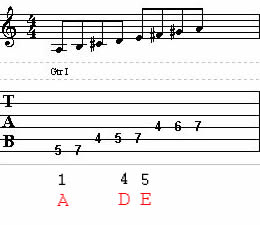The vast majority of contemporary blues music is based on what is termed a 12-bar format. That is, the main body of a song follows a set pattern of chords over 12 bars of music that are repeated over and over. Some songs may have several different patterns to give them a bit of variety, but the guts of the song will normally be based on a set chord pattern for every 12 bars of music. So, if someone says to you, “play a 12-bar”, this is what they are referring to.
Blues is not limited to 12-bar patterns. There are also songs based on 8-bar, 16-bar, and 24-bar patterns. We’ll stick to the 12-bar forms here because, as I mentioned earlier, these are the ones you will most often hear played by blues musicians.
The chords most commonly played over these 12 bars of music are the first, fourth, and fifth chords of the key that the song is written in. These are usually referred to by Roman numerals as the I, IV, and V chords. If we take the A major scale, you will see below that these chords are A, D and E respectively;
I ii iii IV V VI vii
A B C D E F# G#
There are dozens of variations to the chord patterns that can be played over the 12 bars and there are also dozens of different chord types that can be used depending on the feel you want to give to the progression. The most commonly used chords are the dominant 7th and 9th chords for a major progression and the minor equivalents of these for minor progressions.
The most basic rhythm is in 4/4 time which means that there are four quarter notes per bar of music, or put more simply, a count of 1,2,3,4 repeated over and over. Other rhythms commonly used are in 6/8 and 12/8 time which are based on triplets.
Let’s now start off with a standard 12-bar blues in its simplest form using the I, IV, and V chords in the key of A in simple 4/4 time.
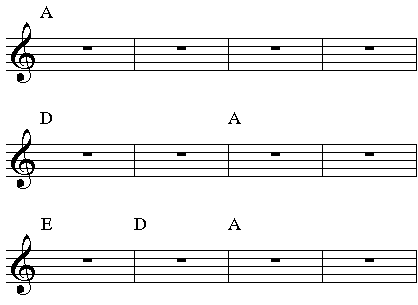
Initially, just play the chords with a downward strum per beat. The chord names and slashes (called rhythm slashes) represent one beat each which makes a total of 4 beats per bar. Keep playing a chord until you reach a new chord at the start of a bar and so forth. When you reach the end of bar 12, keep going by repeating the pattern from bar 1.
The idea here is to learn the chord sequence and begin to feel/hear when the chords should change. After a while, you should be able to hear the musical tension build-up and release with each chord change. You will need to have this feeling for the chord changes firmly entrenched in your brain before getting into the more complicated 12-bar patterns and rhythms.
Get used to playing the A chord using a partial bar with your index finger. Make sure the high ‘e’ string is deadened by the index finger and doesn’t play an F# when you strum. This technique will be important later on when we start to play some of the more complicated shuffle rhythms.
Key Signature
Which three chords we use is determined by the song’s key signature.
Every song has a key signature. They are named after the root note of the originating chord, or the “one” chord, in the song. Most of the time a song will begin and end with the chord that is the song’s key signature.
Without getting too technical, you should have a basic understanding of key signatures and be able to find and play different key signatures as a blues guitarist.
How To Do It
If I say, “Let’s play blues in A”, this means that we’ll be playing blues using A as the key signature. It’s easy to find which chords to use once we know the first chord.
If we were playing in the key of A, we could locate the A on the 5th fret. Then we apply the major scale and count the steps. We want the first, 4th, and 5th notes. In the key of A we end up with A, D, and E- these will be our 3 chords for the key.
One, Four, Five
These chords are more commonly called the one, four, five chords. Roman numerals are often used to represent them:
- 1 = I
- 4 = IV
- 5 = V
There are two common progressions found in blues music. We can easily find which chords to use in any key signature by using the following method.
The “I” chord is the first chord in the key, “IV” is the fourth chord in the key, and “V” is the fifth chord in the key. You can locate your I chord on either the 6th or 5th string and then find the IV and V chords by using the I chord as your guide.
6th String
Using the 6th string, or low E string, your IV and V chords would line up as such:
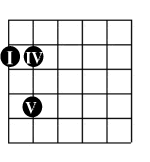

If you applied the diagram to the key of A, you would end up with:
- I = A
- IV=D
- V= E
You may have to practice finding the chords a few times with the guitar in hand, but once you get it down you’ll be good to go. Practice finding the I, IV, V chords in different key signatures.
Can you find them in the key of E? Here’s a hint: use the open low E string for your I chord. You’ll end up with A as the IV chord and B as the V chord.
5th String
If you use the 5th, or A string, as your starting point you can find the IV and V chords here:
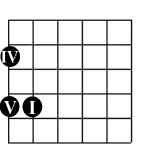

Now on to the actual blues progressions…
12 Bar Blues Progressions
There are dozens of variations to the chord patterns that can be played over the 12 bars and there are also dozens of different chord types that can be used depending on the feel you want to give to the progression. The most commonly used chords are the dominant 7th and 9th chords for a major progression and the minor equivalents of these for minor progressions.
The most basic rhythm is in 4/4 time which means that there are four quarter notes per bar of music, or put more simply, a count of 1,2,3,4 repeated over and over. Other rhythms commonly used are in 6/8 and 12/8 time which is based on triplets.
Let’s now start off with a standard 12-bar blues in its simplest form using the I, IV, and V chords in the key of A in simple 4/4 time:
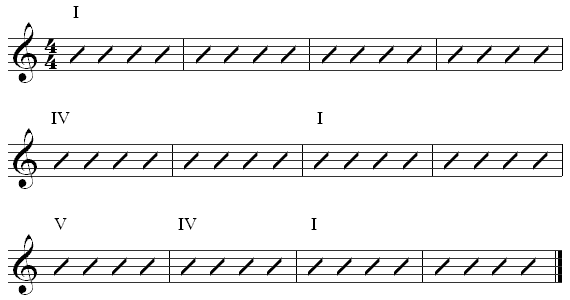

Initially, just play the chords with a downward strum per beat. The chord names and slashes (called rhythm slashes) represent one beat each which makes a total of 4 beats per bar. Keep playing a chord until you reach a new chord at the start of a bar and so forth. When you reach the end of bar 12, keep going by repeating the pattern from bar 1.
The idea here is to learn the chord sequence and begin to feel/hear when the chords should change. After a while, you should be able to hear the musical tension build-up and release with each chord change. You will need to have this feeling for the chord changes firmly entrenched in your brain before getting into the more complicated 12-bar patterns and rhythms.
Get used to playing the A chord using a partial bar with your index finger. Make sure the high ‘e’ string is deadened by the index finger and doesn’t play an F# when you strum. This technique will be important later on when we start to play some of the more complicated shuffle rhythms.
Quick Change Variant
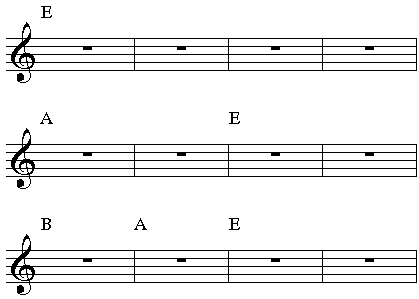
Here’s a variation of the standard 12 bar blues. It uses the “quick change” variant:

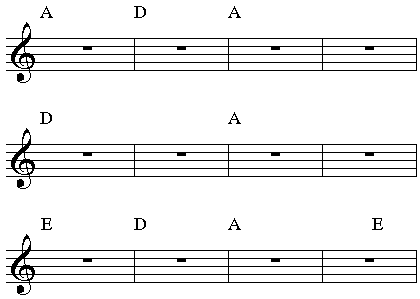
Here are the standard 12 bar blues in E:


PDF Downloads
Download the 12 bar blues progressions in 12 keys.
12 Bar Blues Quick Change Progressions
12 Bar Blues Backing Tracks
This 12 Bar Blues Jam Collection includes the following MP3 backing tracks:
- A Minor Blues
- Shuffle In A
- Slow Blues In A
- Walking Bass In A
- B Flat Jazz Blues
- Walking Bass in B Flat
- Walking Bass in B
- Shuffle In B
- Slow Blues In B
- Walking Bass In C
- Shuffle in C
- Slow Blues In C
- C Sharp Minor Blues
- Funky Blues In C Sharp
- Walking Bass In C Sharp
- Slow Blues In D
- Texas Blues In D
- Walking Bass In D
- D Sharp Minor Blues
- Walking Bass In D Sharp
- E Minor Blues
- Slow Blues In E
- Texas Blues In E
- Walking Bass In F
- Shuffle In F
- Slow Blues In F
- F Sharp Shuffle
- Walking Bass In F Sharp
- Slow Blues In F Sharp
- G Minor Blues
- Walking Bass In G
- Shuffle In G
- Slow Blues In G
- G Sharp Shuffle
- Walking Bass In G Sharp
- Slow Blues In G Sharp
Download it here:
